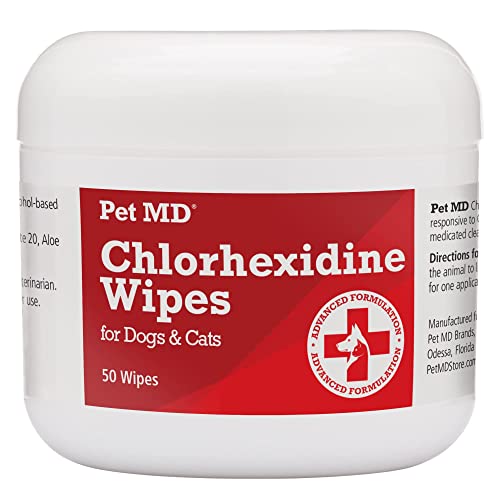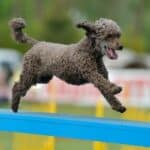Unsightly stains beneath the eyes of a Maltese is so common that many people mistakenly believe that the discoloration is normal and to be expected. This, however, is not the case. Those ugly stains are the direct result of epiphora, an overproduction of moisture from the eyes and are abnormal.
The good news is that the stains can not only be removed but actually can be prevented from occurring in the first place.
Need to remove the stains from your Maltese, ASAP? Here are some things you can try…
- Tear Stain Wipes — Chlorhexidine Wipes by Pet MD get to the root of the problem with their antiseptic, antibacterial, and antifungal ingredients.
- Stain Removing Liquid — Arava Bio Tear Stain Cleaner is highly rated for it’s ability to remove crust and discoloration on your pups facial fur.
- Crust-Removing Comb — Yes, the Mindful Pets comb was specifically designed to gently remove crust from around your pup’s eye.
Understanding why that snowy white fur darkens over time should be your first step in eliminating the problem, so let’s take a quick look at what lies at the heart of the issue before we launch into a treatment plan to resolve the discoloration.
What Causes Tear Stains on Dogs to Occur?
Short-faced breeds, like the Maltese, are more prone to the condition due to the short, narrow, often crooked tear ducts. While staining can occur in dogs of any color, it’s especially noticeable on white dogs as the dark, rust-colored streaks stand out in sharp contrast against the bright white.
Without getting too technical, here is what takes place.
- The eyes are triggered to produce too many tears.
- These tears leak from the eyes and keep the surrounding area consistently damp.
- This dampness can then cause one of the following two issues (and sometimes both simultaneously) to develop.
Porphyrins
As the body breaks down red blood cells, iron-containing molecules, called porphyrins, are produced. These waste products are then eliminated from the body through urine, feces, saliva, footpads, and yes, tears.
When the porphyrins are in prolonged contact with the fur, reddish or rust-colored stains result because of the iron found in the molecules. Exposure to sunlight will cause iron-related stains to darken even more. If your dog’s stains are on the red side, chances are porphyrins are to blame.
In some dogs, a round of antibiotics does seem to provide temporary relief from tear staining which suggests that the presence of bacteria in the tears also contributes to the discoloration of the fur.
Malassezia
Malassezia, also commonly known as Pityrosporum, may sound like a strange tropical disease, but it is actually just yeast and is a common cause of canine skin and ear infections.
According to Dr. Alice Jeromin, Malassezia is a normal inhabitant of canine skin (human skin too) and usually doesn’t cause any problems, though when given the right conditions, an overgrowth can occur resulting in dreaded yeast infections.
In order to thrive, yeast needs a warm, moist environment. You guessed it – those moist patches under your dog’s eyes are the ideal spot for yeast to make itself right at home. Malassezia overgrowth will cause brown discoloration to appear in the affected region.
So, if you are seeing brown stains on either side of your Maltese’s nose, you are most likely dealing with a yeast infection caused by the overproduction of tears.
Why Are an Abundance of Tears Being Produced in the First Place?
It would be nice if we could easily give a direct answer here, but unfortunately, many factors can cause epiphora to develop. Here is a list of the more common causes.
- Poor quality diet.
- Drinking tap water.
- Eye infections.
- Ingrown eyelashes.
- Scar tissue from previous infections.
- Long fur irritating the eyes.
- Small or blocked tear ducts.
- Overly large tear ducts.
- Teething in puppies.
- Entropion (inward-facing eyelid).
- Allergies.
- Corneal ulcers.
- Glaucoma.
How to Remove Tear Stains From Your Maltese’s Face
In many cases, tear staining is merely a cosmetic concern and won’t detract from your dog’s quality of life. Sometimes, though, infections can result. It is usually best to stay on top of the problem before a small issue morphs into a large one.
While removing your dog’s tear stains may be simple enough, the fact is that they are very likely to return until the issue that is causing the overflow of tears is dealt with first. For this reason, we strongly recommend that you complete the first step before moving on to eliminating the stains.
Step 1 – Visit Your Veterinarian
Your veterinarian can perform a thorough eye examination to determine what exactly is the reason for all those tears. He or she will most likely check for drainage problems with the tear ducts, signs of infection, improper eyelash and eyelid positioning, scar tissue or foreign objects that block tear ducts, and other common causes such as allergies.
Your veterinarian should be able to diagnose whether the staining is a result of porphyrins, yeast, or bacteria and identify the underlying problem. It’s important to know which of these three is causing the stains as treatment will vary for each issue. For example, antibiotics will not be effective if yeast is to blame and may even make the yeast infection worse.
Many medical concerns such as clogged tear ducts can be easily remedied, though surgery may be required to correct deformities such as entropion.
Once a diagnosis has been given and a treatment plan is formed, you can move on to removing the ugly stains.
Step 2 – Trim Fur Around Face
Clipping the hair around the eye area or having a groomer do it for you will give you several advantages in your battle against tear stains.
- The area will benefit from increased air circulation and thus remain relatively drier.
- The application of cleansing treatments will be faster and easier, and any medications will be better able to reach the affected skin.
- Long hairs will no longer blow back into your dog’s eye causing irritation.
- Trimming away permanently stained fur allows you to effectively clean the shorter fur that has not yet been permanently discolored.
Step 3 – Decide on a Product for Removing Tear Stains
There is a vast variety of products that will work to remove facial stains. While some must be purchased, there are others that you likely already have in your home. Regardless of which option you go with, please be mindful of your dog’s eyes during application and never use bleach or any products that contain bleach.
Cleansing Wipes
Pre-soaked wipes are a great, convenient option for eliminating unsightly tear stains and come ready to use right out of the tub. Similar in design to baby wipes, these wipes are already soaked in the cleaning solution and are wet and tough enough to handle the job at hand while not being messy and overly saturated.
Stain removing wipes require no special applicators and do not need to be rinsed off. Just grab one for each eye to avoid the possibility of spreading bacteria or infection, wipe the soiled area for a minute or two, and that’s it.
Most Popular Stain Removing Wipes
Angels’ Eyes Gentle Tear Stain Wipes contain soothing Aloe vera and chamomile extract to help alleviate your pet’s discomfort caused by irritated skin. Gentle enough for daily use, Angels’ Wipes contain no bleach, harsh chemicals, or antibiotics.
Petpost! Tear Stain Wipes effectively lighten tear stains with a unique formula that includes Aloe vera, coconut oil, and juniper berry oil. The manufacturer claims that with regular use, these wipes will help to prevent future stains from occurring and backs up their claim with a 100 % money-back guarantee.
Veterinarian formulated Trueblue Safe and Sure Eye Wipes come pre-soaked in an all-natural botanical blend containing cucumber, chamomile, Aloe vera, vitamin E, and witch hazel.
Chlorhexidine Wipes by Pet MD are antiseptic, antibacterial, and antifungal wipes that will fight any yeast infection caused by epiphora. Use with caution though as these wipes are not meant to come in contact with the eyes. Only use if a yeast or bacterial infection has developed.
Tear Stain Removing Liquids and Powders
There are many tear stain removing products on the market today, but ironically, not all of them are necessarily safe to use around the eye area. Look for products that are made with all-natural ingredients or those that are, at the very least, free from potentially harmful ingredients.
Burt’s Bees remover is one all-natural, pH balanced product that is free from annoying fragrances, chemicals, sulfates, and colorants. Simply apply the cleaning liquid to a cotton ball and gently wipe away stain-causing particles. When used daily, whiter fur will be noticeable within 15 – 30 days.
Arava Bio Tear Stain Cleaner is another great, 100% all-natural solution. This double-acting cleanser penetrates the hair structure to remove existing stains and helps to prevent new stains by killing the bacteria and microorganisms that cause them. Just apply with a swab or cotton ball, allow to penetrate for one hour, and wipe away the remains. Arava offers a money-back guarantee if you aren’t fully satisfied, but be aware that the product may take as long as 4 – 8 weeks to produce results.
Always Bright Eyes Complete Set is a kit that comes with a liquid cleanser, a drying powder, and a pair of applicator brushes. The all-natural, herbal liquid cleanser is applied first to cleanse and eliminate bacteria and yeast. Next, the all-natural powder is applied to keep the area dry and to prevent the regrowth of microorganisms. Always Bright Eyes also offers a money-back guarantee.
Combs
Another option is to carefully comb away the dried build-up, mucous, and stains with Mindful Pets combs. This combo pack includes two combs. One has slightly wider spacing between the 65 pins and should be used first to work through the mats and dried gunk that has accumulated. The second comb has pins set closer together to remove finer bits of debris.
Home Remedies
Some common household items can effectively combat your dog’s tear stains. As with commercial products, be careful not to allow your treatment of choice to come in contact with your dog’s eyes.
Try applying one or more of these dry products with a toothbrush (designated solely for this purpose) or an eyebrow/eyelash brush to expertly brush out the tear stains and gunk while keeping the area nice and dry.
- Baking soda
- Cornstarch
- Boric acid powder
There are several liquid products that will help to lighten and remove stains as well. Believe it or not, some Maltese owners have had excellent results using a contact lens cleaning solution to fight tear stains. This method actually makes a lot of sense because the solution was designed to be gentle and safe for the eyes while efficiently cleaning and sanitizing as well.
Other owners of white dogs prefer to use hydrogen peroxide. This must be used with great care and at most only once a week to avoid irritating the sensitive facial skin.
Step 4 – Prevent Stains From Reoccurring
Once the stains have been removed, you’ll want to take a proactive approach to prevent them from recurring.
Steps to Prevent Recurrence
- Keep the eye area neatly trimmed.
- With a soft tissue, wipe the eyes, and dry the surrounding area several times per day.
- Routinely clean the eyes with sterile eye wash pads.
- Switch to organic dog food to avoid harmful ingredients.
- Use only stainless steel or glass bowls for food and water.
- Use only filtered or distilled water.
Supplements
Many Maltese owners have found success in using supplements to keep tear stains at bay, especially those that are caused by porphyrins. Supplements, such as those by NaturVet, Angels’ Eyes, VetClassics, and Veterinary Formula, work from the inside out to help the eyes to function normally and to reduce the number of porphyrins produced and oxidized.
Summary
Tear stains don’t have to be a permanent cosmetic feature on your Maltese. Both store-bought removers and ordinary household products can eliminate unsightly discoloration and prevent stains from reappearing. Whatever treatment you choose, follow the instructions carefully to achieve the best results.
Frequently Asked Questions
What dog breeds most commonly get tear stains?
The Maltese isn’t the only breed to suffer from chronic tear staining. Many other breeds, including Shih Tzu and Poodle, also commonly experience staining around their eyes. The thing is, staining can occur in any dog, it’s just more noticeable in light-colored dogs. And certain breeds have a tendency to appear in lighter colors.
Last update on 2024-04-26 at 02:41 / Affiliate links / Images from Amazon Product Advertising API












